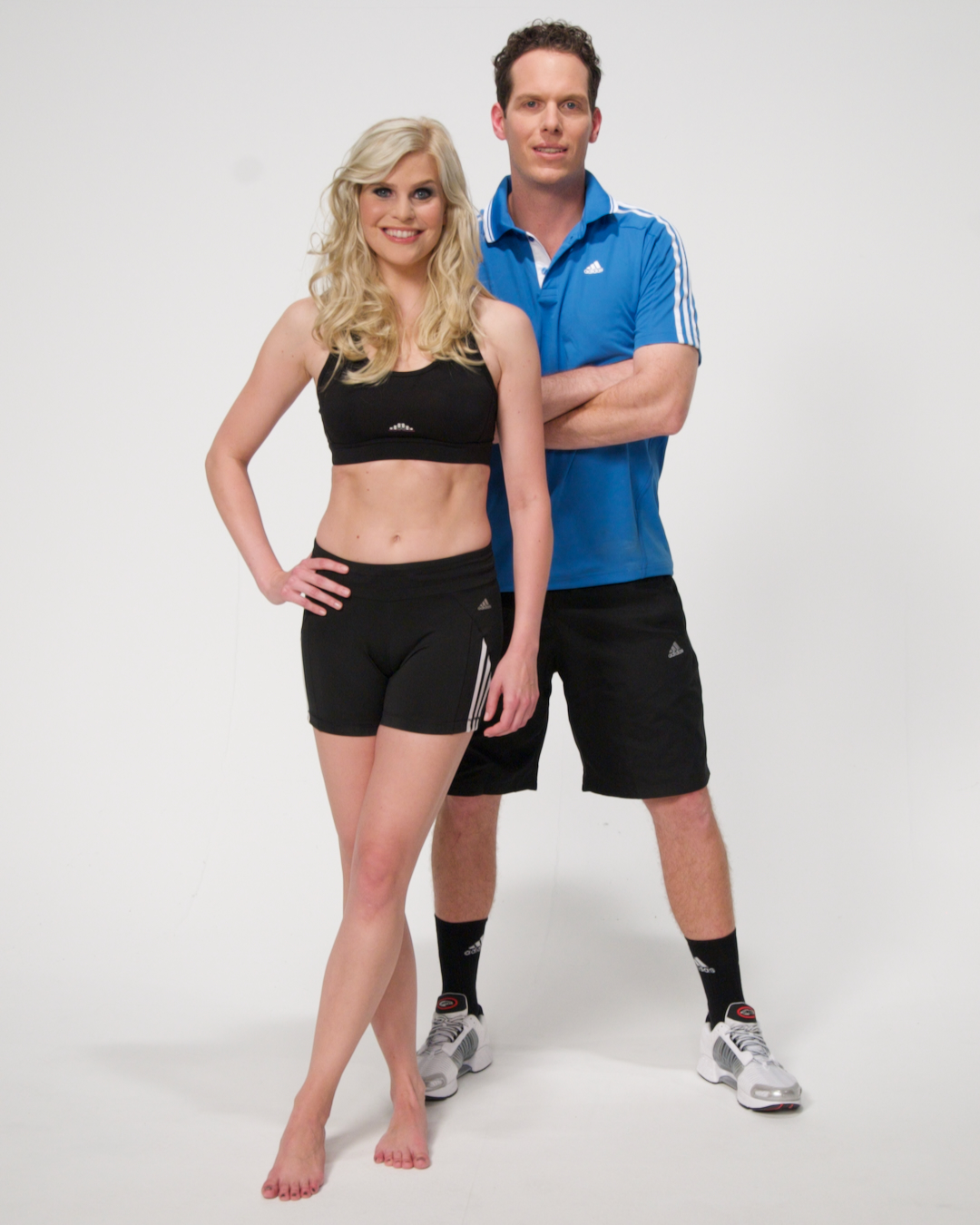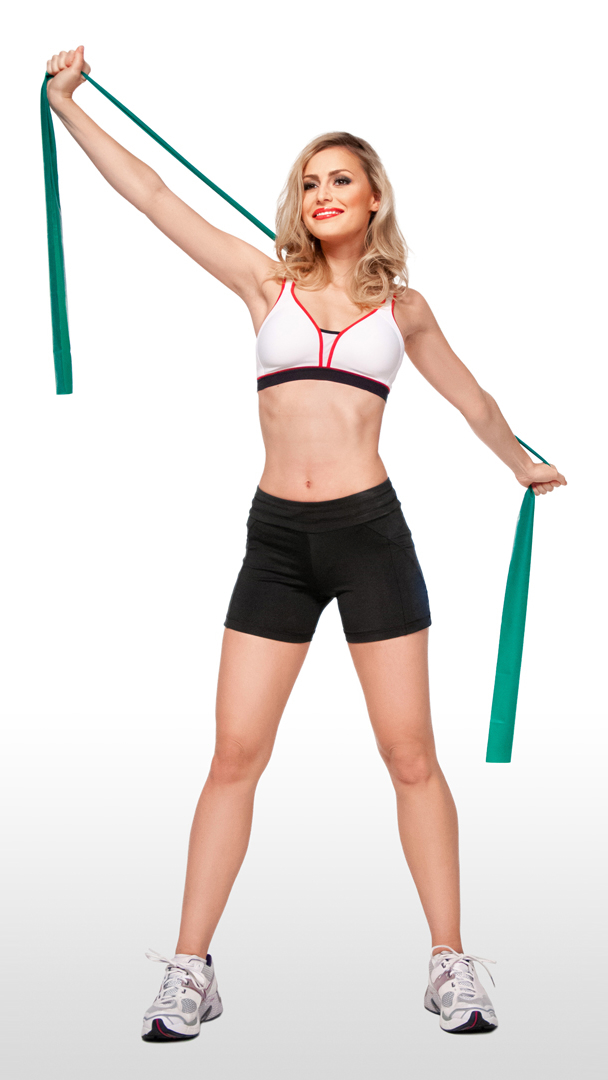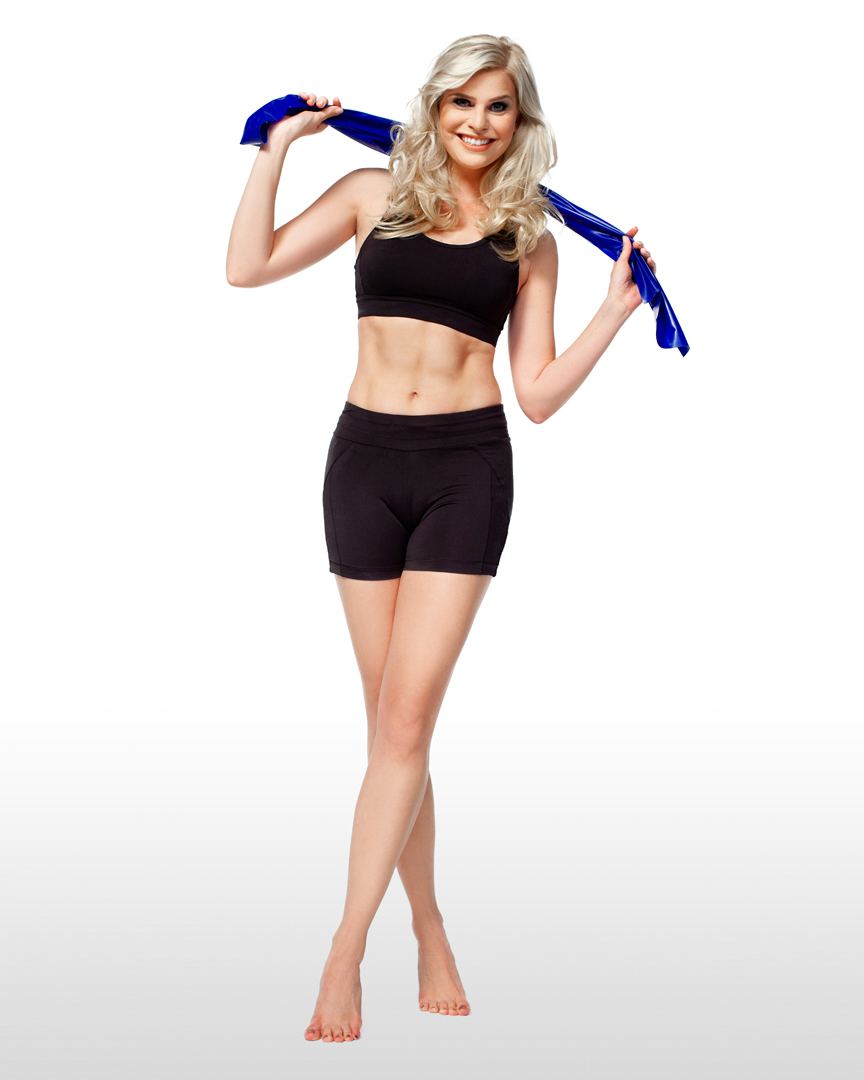
Dynamic stretching warm up exercises are mainly being used prior to your workout or match to get your body ready for action.
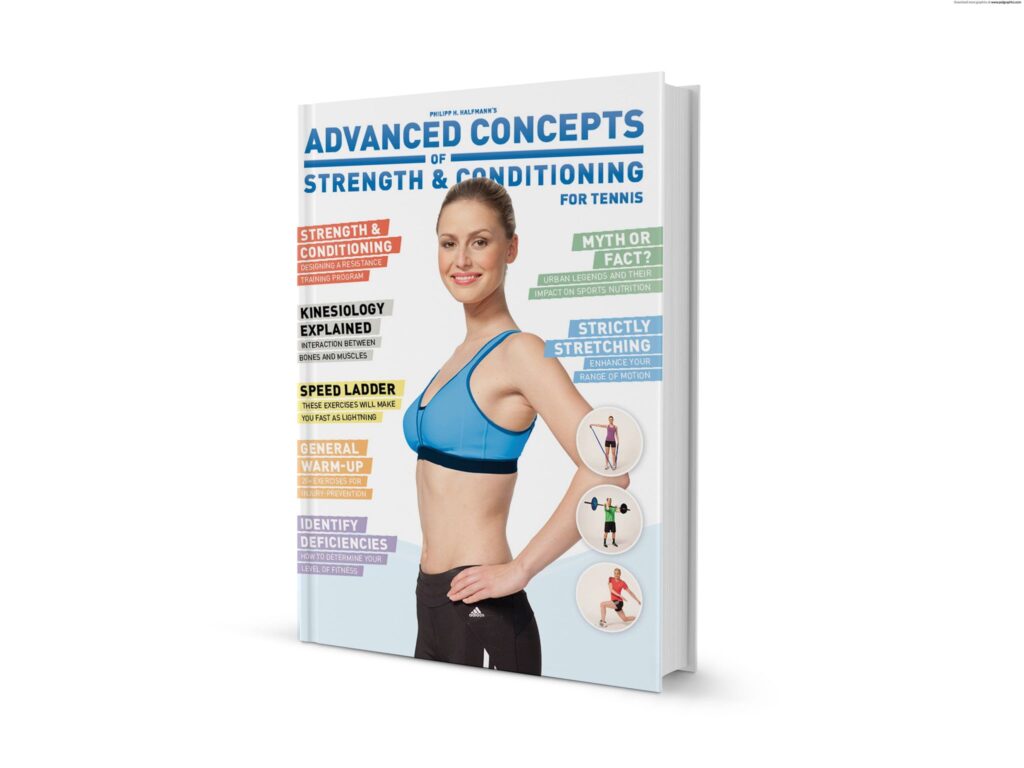
Another aspect to dynamic warm up exercises is that you can decrease the risk for injury while getting your mind and body ready for action.
We also have more information for you on the benefits of a proper warm up routine and we even have 15 perfect warm up exercises for you before you start to play tennis.
If you prefer to devise your own dynamic warm up routine take a look at the following 21 dynamic stretching warm up exercises.
Alternative you can take a look and use the leg warm up for beginners and advanced athletes.
Dynamic Stretching Warm Up Exercises Training Recommendations
Use the time wisely to get yourself ready physically and mentally. That means you are getting your mind and body ready for action. Ideally you want to go onto the court ready to sprint, jump and hit balls with maximum power.
In other words, this is not the time to mess around and simply go through the motions. Instead you want to break a sweat before you hit the first tennis ball and jump on your opponent for an early break.
Therefore, we recommend that after you finish your dynamic warm up exercises you perform the shoulder circuit first before you jump into various tennis footwork drills at maximum speed until you break a sweat.
Now you are a well-oiled machine ready for immediate action! This may be the difference between being down 0:3 or leading by 3:0.
1. Dynamic Abductor and Adductor Stretch: Bilateral Lunge
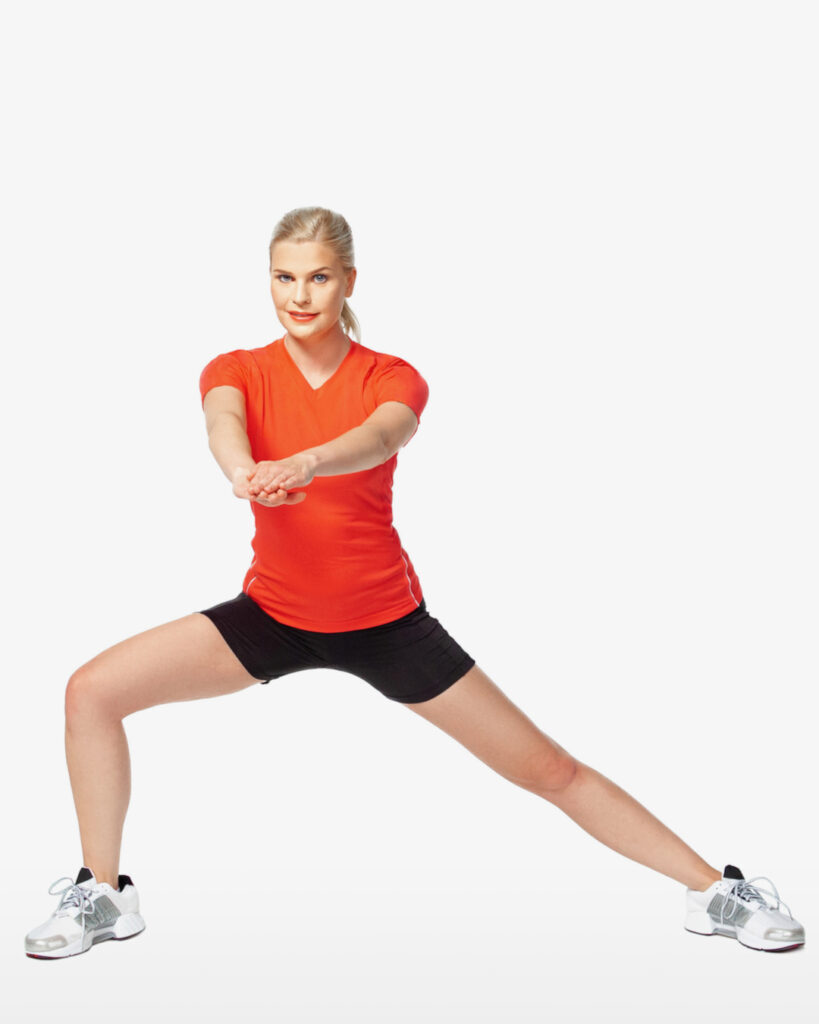
The Bilateral Lunge is a dynamic abductor stretch and adductor stretch, which reduces the risk of injury for the hip musculature.
Additionally, the bilateral lunge adductor stretch also optimizes power-production capabilities and improves flexibility and stability by increasing muscle tissue temperature.
The dynamic abductor stretch and adductor stretch is one of the essential dynamic stretching exercises for tennis players because it warms up the musculature necessary for stroke production and lateral movements along the baseline.
Therefore, the bilateral lunge should be a part of your dynamic warm up routine that you perform prior to playing tennis.
Even though you might have done some running prior to doing your dynamic stretch routine, do a few easy warm up lateral lunges before you do the bilateral lunges at full range of motion to avoid pulling the adductors.
You want to take a step sideways to your left and bend the knee in a controlled fashion until the left knee is at 90 degrees and the right leg is straight.
Make sure to keep the weight on the heels so that your knee doesn’t protrude over the toes. Then push off with the left foot again and return to athletic stance.
Now perform a lateral lunge to the other side.
Abductor & Adductor Stretch Description Summary
- Take an athletic stance; stand straight, feet are shoulder-width apart; knees slightly flexed; toes point slightly outward (10˚-20˚)
- Step sideways with the left foot and bend the left knee until left knee is at 90˚ and right leg is straight; knee must not move beyond toes; toes point slightly outward (10˚-20˚)
- Push-off with the left foot and return to athletic stance
- Lunge to the right side until right knee is at 90˚; knee must not move beyond toes; toes point slightly outward (10˚-20˚)
Targeted Musculature
It targets the:
- hip adductors
- hip abductor
- glutes
2. Dynamic Bilateral Lunge Stretch With Trunk Rotation
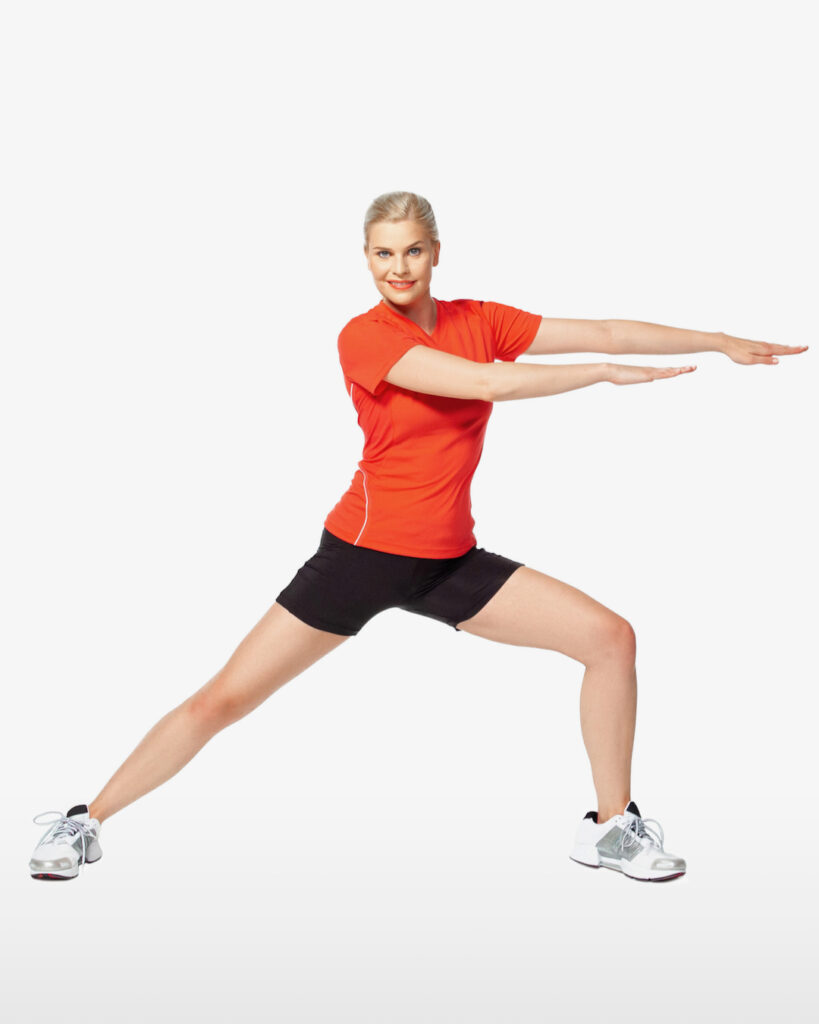
The Lateral Lunge Stretch with Trunk Rotation is a multiplanar dynamic stretching exercise for the legs and obliques that is ideal for tennis players.
The lateral lunge stretch with trunk rotation reduce the risk of injury, optimizes power-production capabilities, improving flexibility and stability by increasing muscle tissue temperature.
This dynamic stretch is essential for tennis players because it mimics the synchronized muscle activation seen during open stance stroke production and lateral baseline movement and hence is preparing you for match play.
Therefore, the lateral lunge with trunk rotation should be one of the stretches in your dynamic stretching routine
If you haven’t done any lateral lunging before then warm up the adductors first before stepping into full range of motion.
Lateral Lunge Stretch With Trunk Rotation Description Summary
- Stand straight with feet close together
- Step sideways with the left foot into a lateral lunge until knee is at 90 degrees
- Rotate trunk to the left and to the right
- Push off, extend knee and return to starting position
- Side-Step
- Step sideways with the right foot into a lunge
- Rotate trunk to the left and to the right
Targeted Musculature
It targets the:
- hip extensors
- hip adductors
- hip abductors
- piriformis
- glutes
- deltoids
- obliques
3. Bilateral Dynamic Squat Stretch
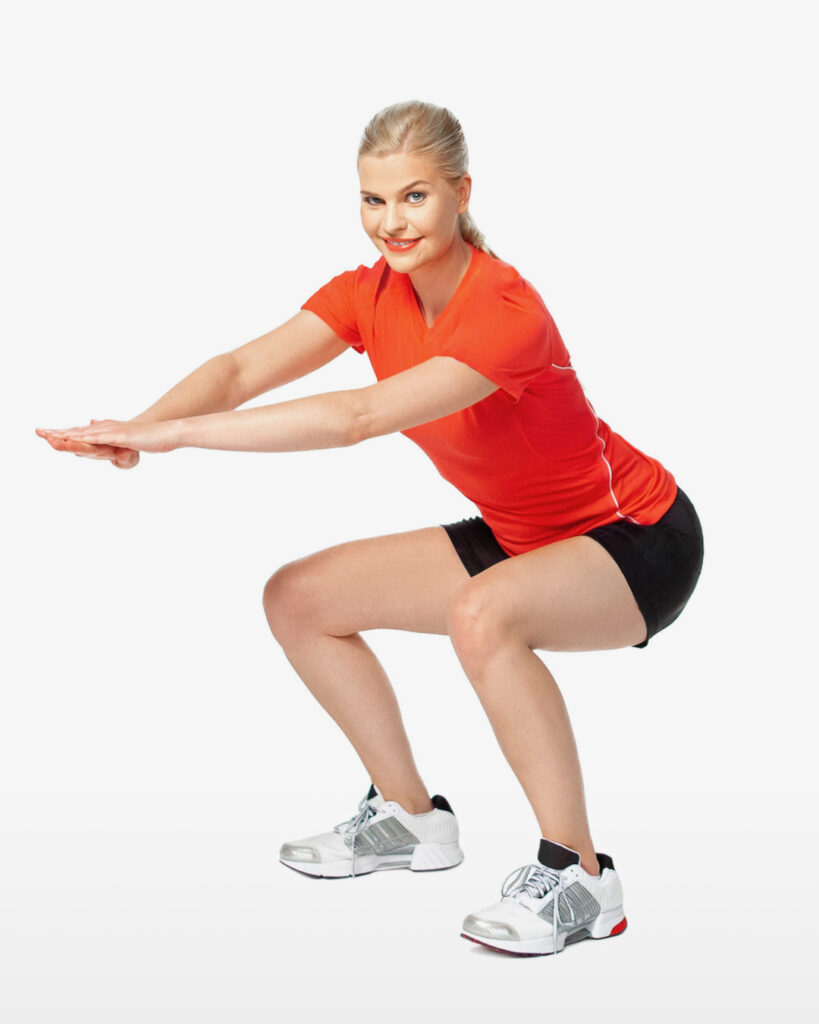
The bilateral dynamic squat stretch prepares the various muscles attaching to the hip for explosive lateral movements during match play.
This bilateral dynamic squat stretch reduces the risk of injury and optimizes your power-production capabilities while improving flexibility and stability by increasing muscle tissue temperature.
It is convenient to add the squat stretch into your dynamic stretching routine because it warms up various muscles simultaneously, which allows you to save some time.
Simply step sideways into a squat until your knees are at 90 degrees of flexion. Distribute the weight over the heels so your toes don’t protrude over the toes.
Then push back and return to athletic stance and repeat the same movement to the opposite side.
Bilateral Squat Stretch Description Summary
- Stand in athletic stance (feet are shoulder-width apart; knees are slightly bent)
- Step sideways
- Flex hips until knees are at 90˚; keep weight on the heels of the feet and arms out in front of you
- Extend hips and push back into athletic stance
Targeted Musculature
It targets the:
- glutes
- hip adductors
- hip abductors
- piriformis
4. Dynamic Bilateral Squat With Trunk Rotation Stretch

The Dynamic Bilateral Squat with Trunk Rotation Stretch is a total body dynamic stretching exercise for tennis players.
Its main focus is to prepare you for explosive movements on the tennis court during stroke production and lateral movement along the baseline.
By increasing muscle tissue temperature the dynamic bilateral squat with trunk rotation stretch optimizes power-production capabilities, reduces the risk of injury and improves flexibility and stability.
Bilateral Squat With Trunk Rotation Stretch Summary
- Stand straight with feet close together
- Step sideways with the left foot and drop into a squat
- Rotate trunk to the left and to the right
- Extend knees and move feet close together
- Side-Step
- Step sideways with the right foot and drop into a squat
- Rotate trunk to the left and to the right
Targeted Musculature
It targets the:
- hip extensors
- hip adductors
- hip abductors
- piriformis
- glutes
- deltoids
- obliques
5. Butt Kicks Dynamic Quad Stretch

The Butt Kicks is a dynamic quad stretch that focuses on warming up the anterior thigh musculature for explosive movements on the court.
The butt kicks dynamic quad stretch is essential for tennis players since the quadriceps contribute in running and explosive jumps during the serve.
Because the quads can be involved in various knee injuries you should incorporate the butt kicks dynamic stretch to reduce the risk of injury, optimize power-production capabilities and improving flexibility.
Find out more on how to prevent knee pain and improve knee strength or watch the workout video.
Make sure you do the butt kicks in a controlled fashion going through full range of motion for 10 repetitions per leg while maintaining neutral pelvic position.
Butt Kicks Dynamic Quad Stretch Description Summary
- Face forward
- Keep knees & feet inside the shoulders
- Kick yourself in the buttocks with the heels of your feet
- Knees point towards the ground
Targeted Musculature
- Quadriceps
6. Dynamic Cross Over Lunge Stretch
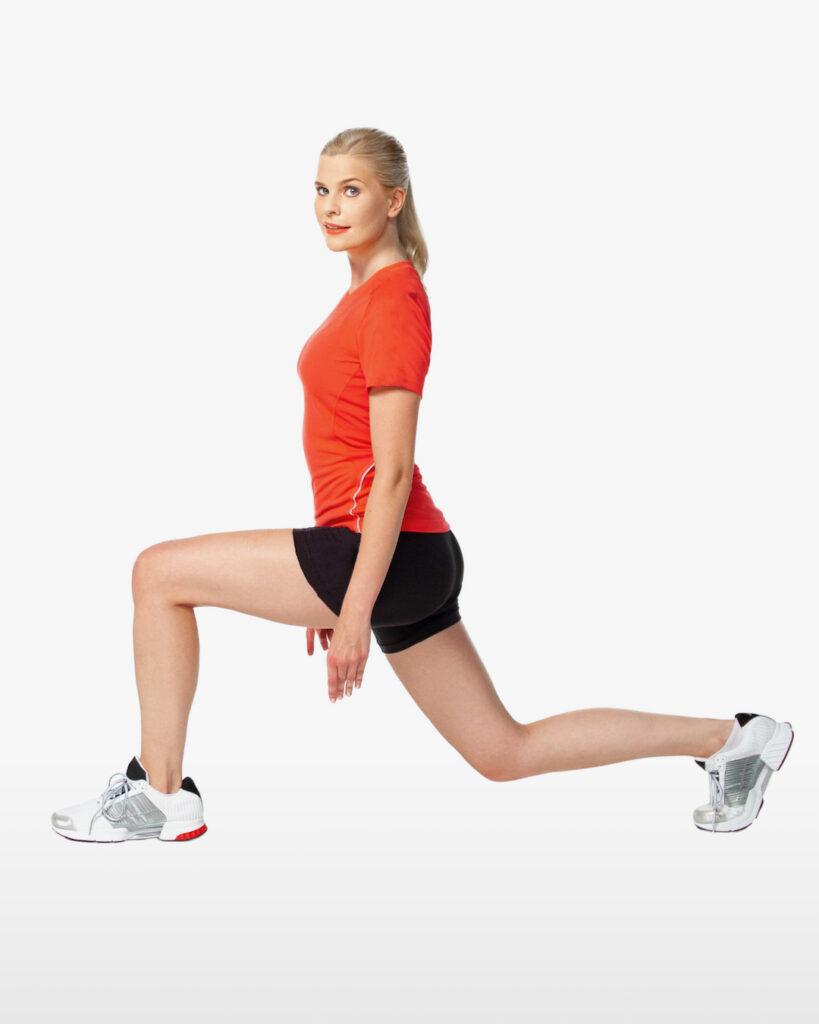
The Dynamic Cross Over Lunge Stretch warms up the knee and hip musculature you use during closed stance stroke production.
The dynamic cross over lunge stretch prepares you for explosive movements, reduces the risk for injury and improves flexibility.
Because the cross over lunge stretch has a dynamic component to it you also can improve stability for groundstrokes while warming up.
To increase the degree of difficulty and increase dynamic stability requirements simply speed up the cross over move.
Regardless of the speed always make sure that you do the cross over lunge in perfect form and in a controlled fashion so you don’t loose stability.
Cross Over Lunge Stretch Description Summary
- Stand up straight; feet are shoulder width apart
- Perform a cross-over move; right leg crosses over behind the left foot, stepping into a lunge; keep weight on the heel of front foot (left foot)
- Move trailing foot (right foot) in line (parallel) with left foot; feet are shoulder-width apart
- Cross over with left foot behind the right foot, stepping into a lunge; keep weight on the heel of front foot (right foot)
- Move trailing foot (left foot) in line (parallel) with right foot; feet are shoulder-width apart
Targeted Musculature
It targets the:
- glutes
- quadriceps
- hamstrings
- abductors
- adductors
7. Dynamic Cross Over Lunge Stretch with Heel Reach
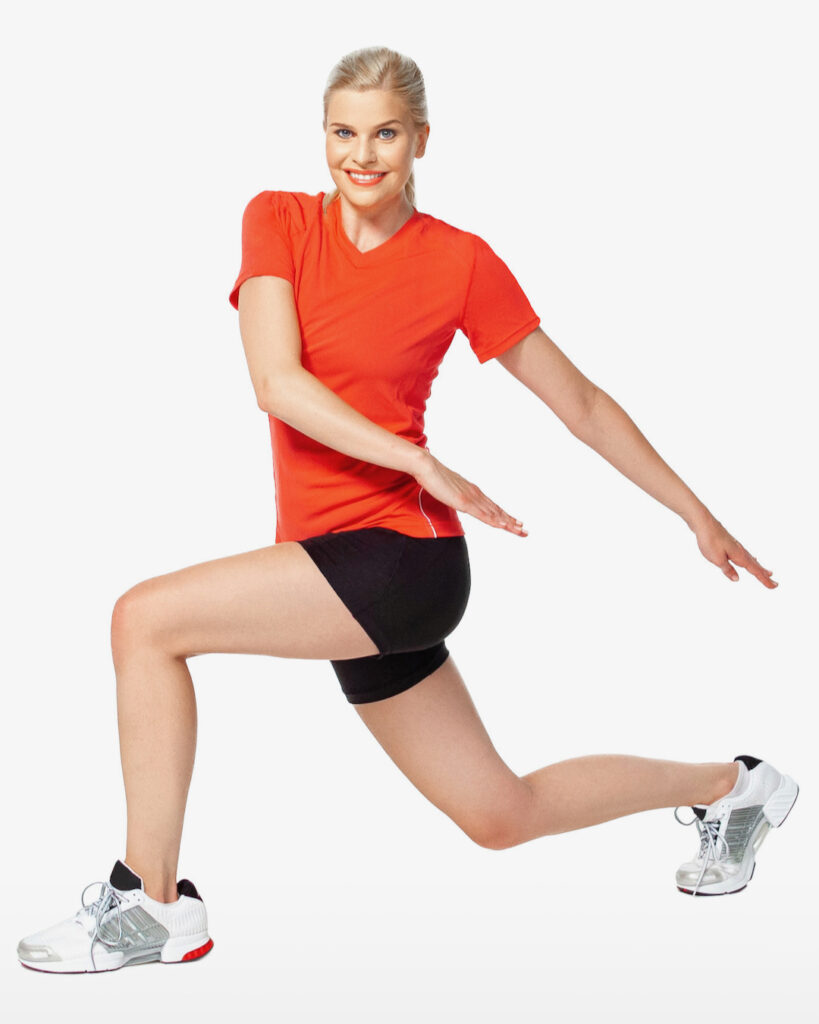
The Dynamic Cross Over Lunge Stretch with Heel Reach warms up the leg and trunk musculature that you use during stroke production in tennis.
The dynamic cross over lunge stretch with heel reach optimizes the respective musculature for explosive muscle action such as seen when hitting groundstrokes.
In addition this lunge stretch reduces the risk for injury, improves flexibility and dynamic stability by increasing muscle tissue temperature.
The faster you are doing the lunge and trunk rotation movement, the higher the dynamic stability requirements are going to be, which increases the degree of difficulty.
Therefore, make sure you learn how to perform the dynamic cross over lunge stretch with heel reach in perfect form first before you speed up the action.
Dynamic Cross Over Lunge Stretch with Heel Reach Summary
- Stand up straight with feet shoulder-width apart
- Perform a cross-over move; right leg crosses over behind the left foot, stepping into a lunge while arms are straight, trunk rotates to the left, and left hand reaches toward the heel of the right foot
- Keep weight on the heel of front foot (left foot)
- Move trailing foot (right foot) in line (parallel) with left foot; feet are shoulder-width apart
- Cross-over with left foot behind the right foot, stepping into a lunge while arms are straight, trunk rotates to the right, and right hand reaches toward the heel of the right foot
- Keep weight on the heel of front foot (right foot)
- Move trailing foot (left foot) in line (parallel) with right foot; feet are shoulder-width apart
- Perform a cross-over move; right leg crosses over behind the left foot, stepping into a lunge while arms are straight, trunk rotates to the left, and left hand reaches toward the heel of the right foot
Targeted Musculature
It targets the:
- glutes
- quadriceps
- hamstrings
- abductors
- adductors
- obliques
8. Duck Walk Dynamic Stretch
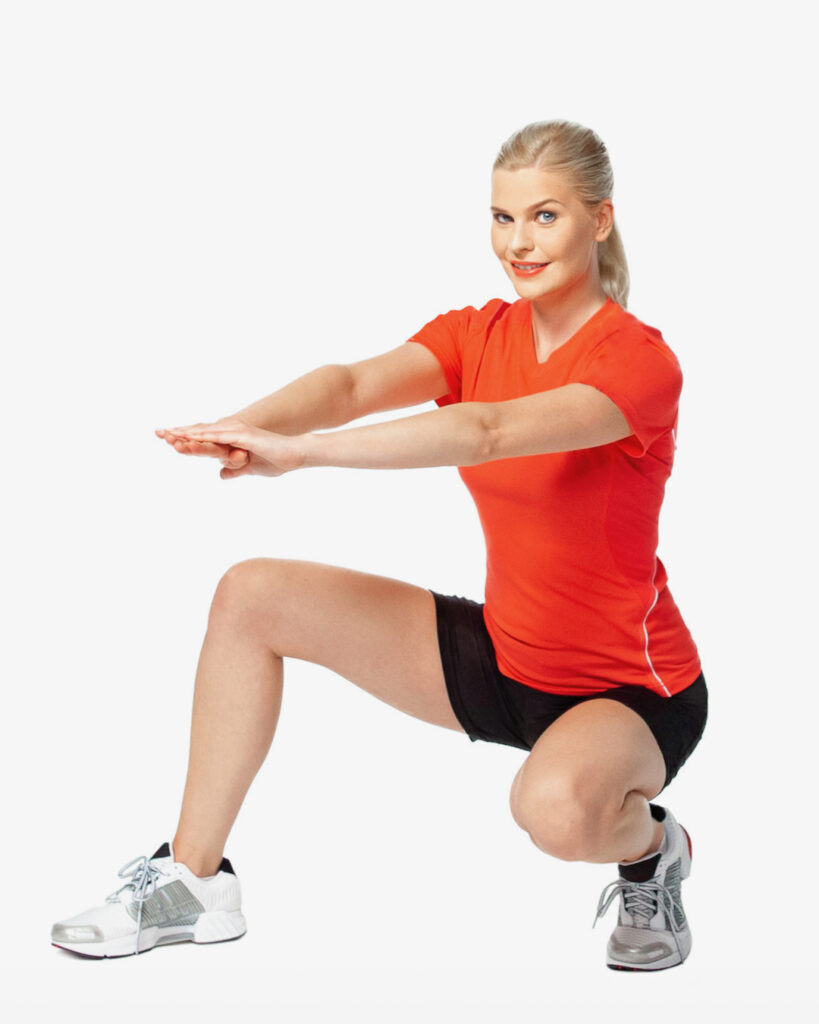
The Duck Walk Dynamic Stretch is a tennis warm up preparing various muscles of the lower extremities for explosive movements.
The duck walk dynamic stretch also opens up the groin area and by increasing muscle tissue temperature the duck walk reduces the risk for injury and increases flexibility.
The goal is to get in the lowest squat position possible but that also puts more stress on the quadriceps and patella tendons.
Therefore, it is advisable that you start in a squat position of 90 degrees knee flexion and gradually move into a deeper squat position while duck walking forward.
Duck Walk Dynamic Stretch Progression
If you are a beginner, as shown in the video, then you can keep the hands in front of your body while distributing your body weight through the heels because that makes it easier to maintain dynamic stability during the duck walk.
For advanced athletes simply take the hands behind the head or reach with your arms over the head while performing the duck walk. This way the dynamic stability requirements are elevated, making this tennis warm up more challenging.
Duck Walk Dynamic Stretch Description Summary
- Feet are shoulder width apart
- Drop into the lowest squat attainable
- Look up towards the sky
- Back remains straight
- Weight remains on the heels
- Place hands behind your head so that elbows point sideways (shoulder is at 90˚)
- Walk forward using small steps
Targeted Musculature
It targets the:
- glutes
- quadriceps
- hip adductors
- dorsi flexors
9. Dynamic Lunge and Ankle Reach Stretch

The Dynamic Lunge and Ankle Reach Stretch warms up the musculature used when hitting groundstrokes in closed stance.
The dynamic lunge and ankle reach stretch is a total body stretching exercise that you should include into your pre-match warm up routine because it prepares various muscle groups simultaneously.
Its purpose is to prepare the musculature for explosive movements, reduce the risk of injury and improve flexibility and dynamic stability by increasing muscle tissue temperature.
Progression for the Dynamic Lunge & Ankle Reach Stretch
As a beginner you want to perform the dynamic lunge and ankle reach stretch in a controlled fashion, especially during the trunk rotation, so that you can maintain dynamic stability throughout the stretch.
Advanced athletes can speed up the action and maintain a narrow base during the lunge position to increase the dynamic stability requirements.
Dynamic Lunge & Ankle Reach Description Summary
- Take a large step out in front with the left leg
- Drop right knee towards the ground in a controlled fashion until both knees are at 90˚
- Rotate the torso all the way to the right and touch/reach the ankle of the right foot
- Keep weight on forward heel
- Step into another lunge and repeat
Targeted Musculature
It targets the:
- glutes
- quadriceps
- hamstrings
- hip flexors
- obliques
10. Dynamic Forward and Reverse Lunge Stretch
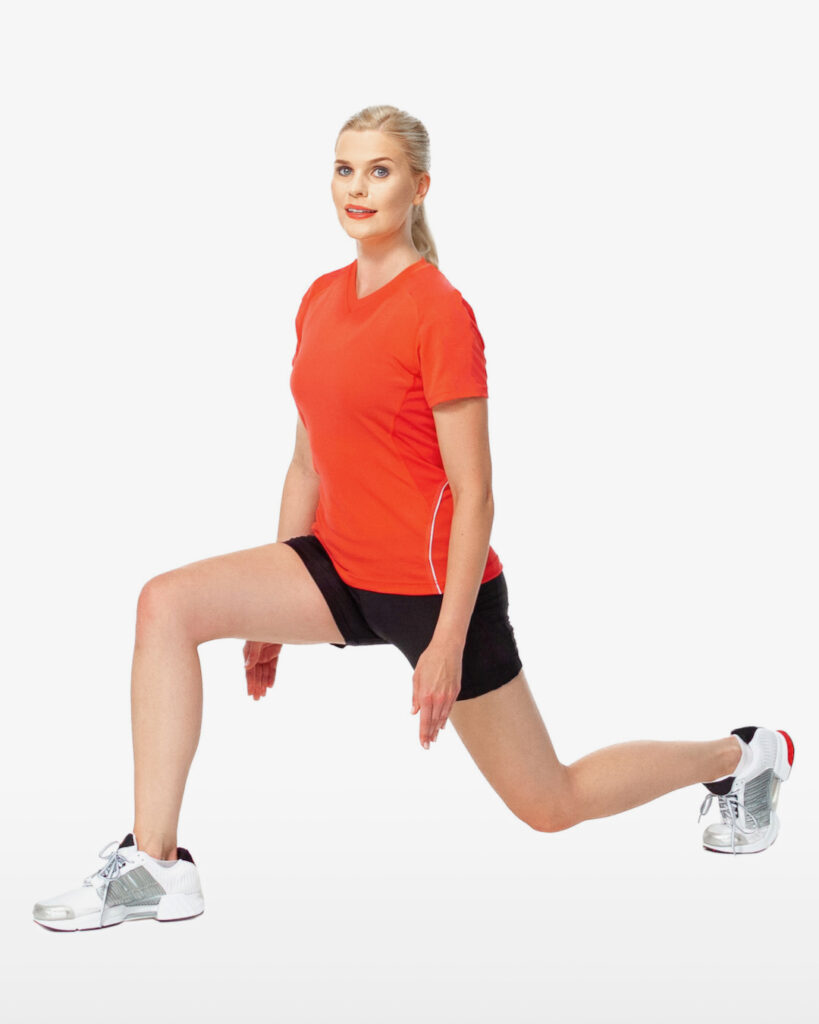
The dynamic forward and reverse lunge stretch enhances dynamic stability and warms up the musculature used during closed stance groundstrokes.
The dynamic forward and reverse lunge stretch prepares you for match play by emulating the movement mechanics during stroke production, where you are lunging forward.
Since the forward and reverse lunge is very dynamic you have to shift the center of mass in a controlled fashion, which allows you to enhance dynamic stability capabilities.
At the same time this dynamic lunge stretch prepares you for explosive movements, reduces the risk for injury and improves flexibility by increasing muscle tissue temperature.
Forward and Reverse Lunge Progression
If you are new to the exercise then focus on performing it in a controlled fashion and in perfect form.
Once you are comfortable with the dynamic forward and reverse lunge you can gradually increase the speed of the action, thereby elevating the dynamic stability requirements.
Forward and Reverse Lunge Description Summary
- Stand straight with feet close together
- Step into a forward lunge with the left foot until left knee is at 90˚; knee must not move beyond toes
- Push-off with the left foot and step into reverse lunge without moving the right foot; right knee is at 90˚
- Step into forward lunge again
- Repeat & switch
Targeted Musculature
It targets the:
- glutes
- quadriceps
- hamstrings
11. Dynamic Glute Stretch: High Knee Pull
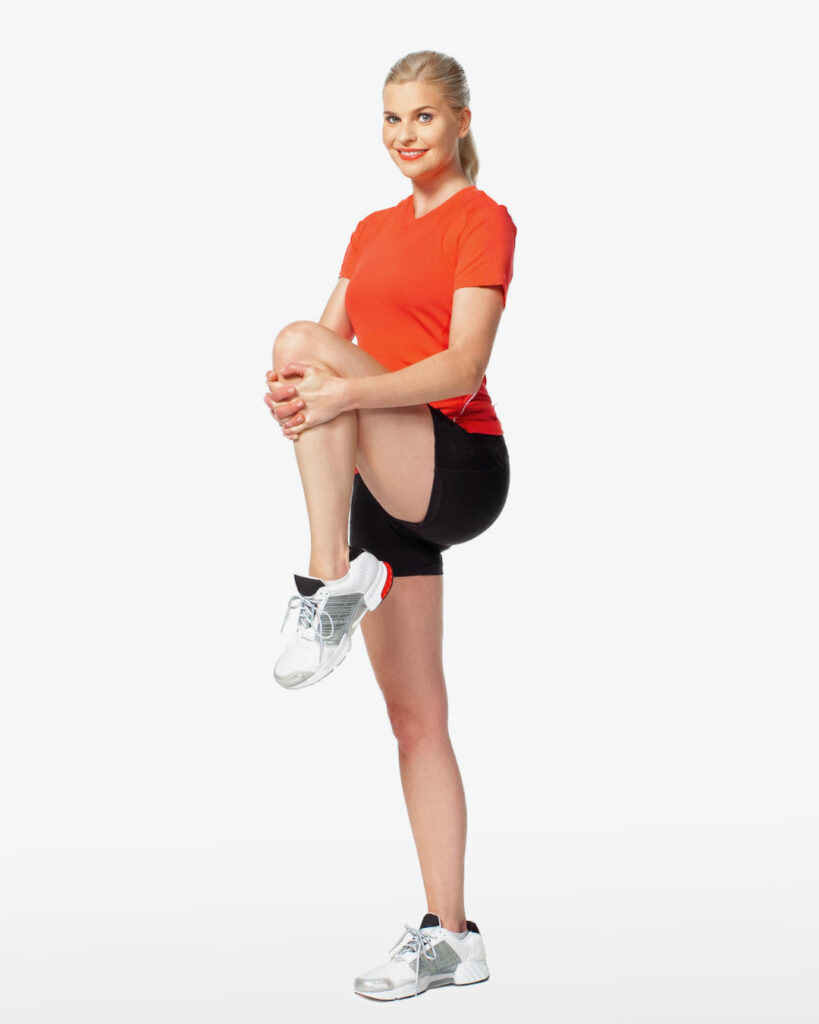
The High Knee Pull is a dynamic glute stretch to prepare you for explosive running and jumping activities.
Additionally, the high knee pull reduces the risk for injury and improves flexibility by increasing muscle tissue temperature.
This dynamic glute stretch is essential because you are using the glutes, hip flexors and adductors with every step you take.
Therefore, incorporate it into your dynamic stretching routine before you start to play tennis.
Aim for 8-12 repetitions per leg.
Dynamic Glute Stretch Description Summary
- Take a step and raise the left knee towards the chest.
- Grab your leg with both hands just below the knee.
- Pull knee as close to your chest as possible.
- Hold the knee for 1 second.
- Release the left knee.
Targeted Musculature
- Glutes
- hip flexors
- hip adductors
12. Dynamic Glute & Calve Stretch: High Knee Pull with Dorsi Flexion
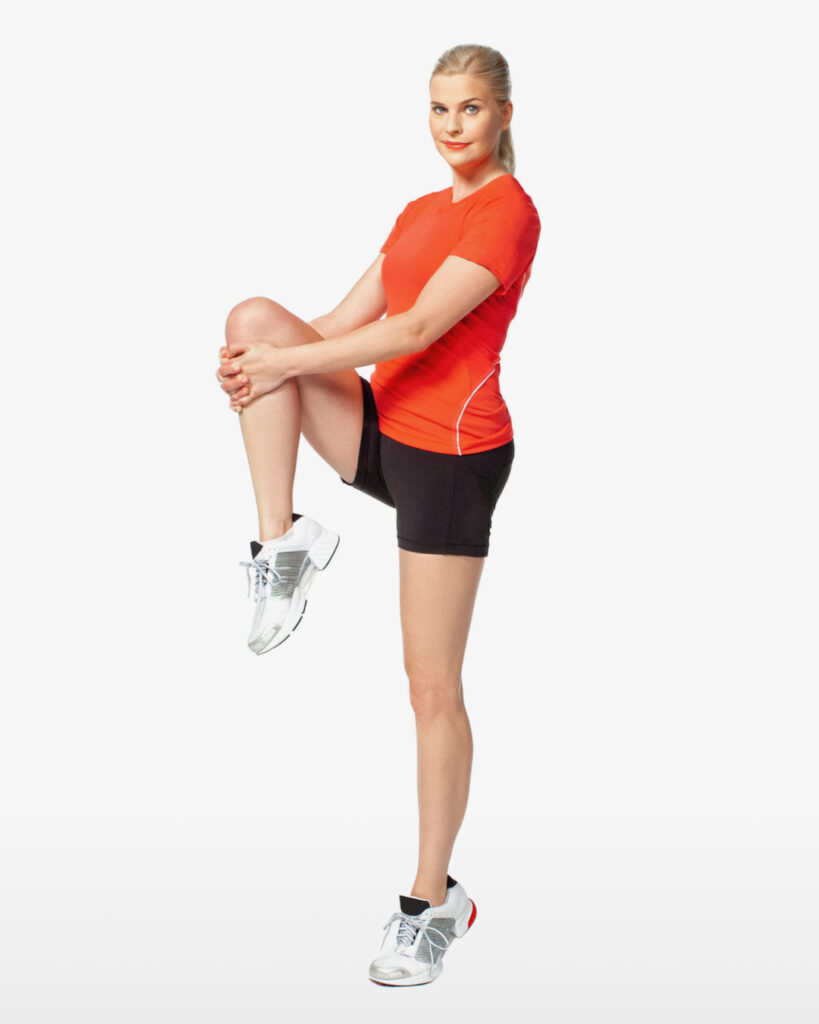
The dynamic glute and calve stretch high knee pull with dorsi flexion prepares the musculature of the buttocks and calves for explosive movements on the court.
The dynamic glute and calve stretch warms up the respective musculature, reduces the risk for injury and improves flexibility and stability by increasing muscle tissue temperature.
The high knee pull with dorsi flexion is one of the essential dynamic stretches for tennis players since it targets various muscle groups used during running, jumping and shot production.
It also supports activation of the leg stabilizers since you are standing on one leg, which has a positive impact on developing and maintaining dynamic stability during shot production.
Therefore, we recommend that you incorporate the high knee pull with dorsi flexion into your tennis-specific dynamic warm up routine.
Glute And Calve Stretch Summary
- 1.Take a step and raise the left knee towards the chest.
- 2.Grab your leg with both hands just below the knee.
- 3.Pull knee as close to your chest as possible.
- 4.During the knee pull flex your feet and stand on your toes.
- 5.Hold the knee for 1 second.
- 6.Release the left knee.
- 7.Take a step and raise the right knee and repeat.
Targeted Musculature
- Glutes
- calves
- hip flexors
- hip adductors
13. Lunge & Overhead Reach Dynamic Stretch
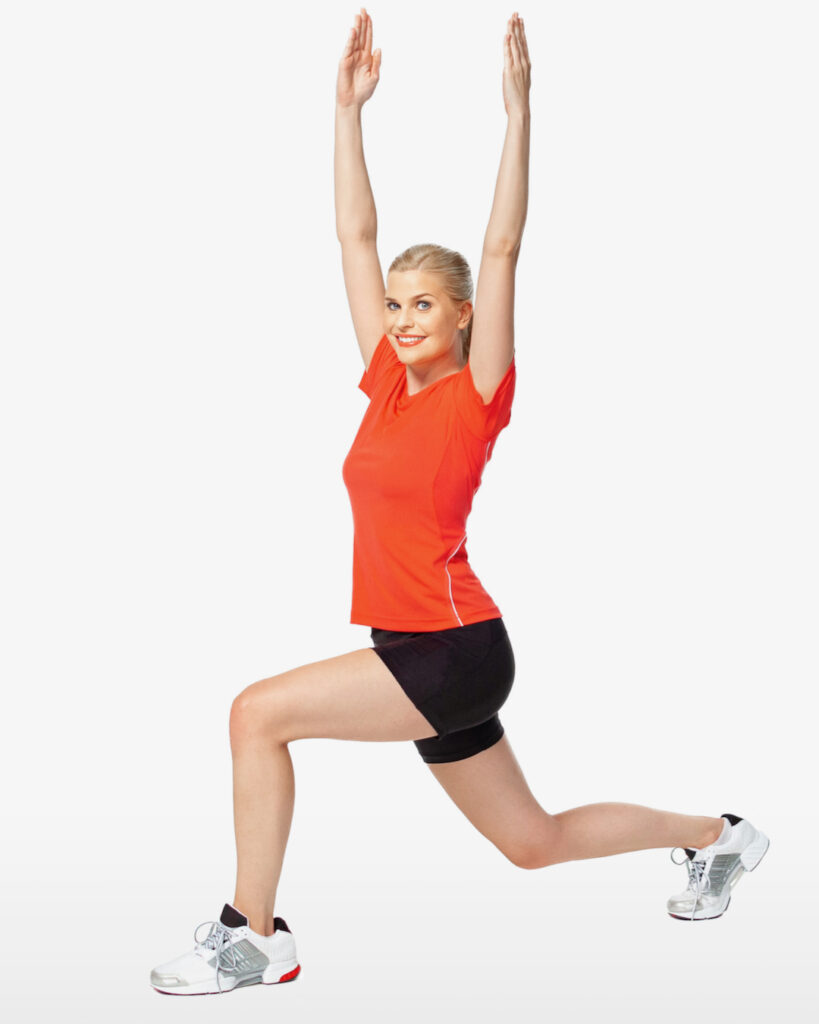
The Lunge and Overhead Reach dynamic stretch warms up the musculature of the legs and trunk used during stroke production.
The lunge and overhead reach prepares you for explosive movements on the tennis court, reduces the risk for injury and improves flexibility and dynamic stability be increasing muscle tissue temperature.
Implement the lunge and overhead reach into your dynamic stretching routine because it is targets various muscle groups at once and hence can help you save some time.
If you were hitting a lot of closed-stance groundstrokes it would make sense to regularly do this stretch because it partially emulates the movement mechanics.
Warming up the abs is also important because they are being used every time you hit a ball.
Tearing your abs can be very painful and prevent you from playing tennis altogether. So do the stretch regularly and minimize the risk for aggregating an injury any further.
Lunge and Overhead Reach Description Summary
- Look forward at all times
- Take a large step out with the leading leg
- Drop trailing knee towards the ground in a controlled fashion until both knees are at 90˚
- Extend the arms and rotate them over your head as far as possible behind your head (full shoulder flexion)
- Keep weight on forward heel
- Stand up and progress into next lunge
Targeted Musculature
It targets the:
- quadriceps
- glutes
- rectus abdominis
- latissimus dorsi
14. Lunge And Twist Core Stretch

The Lunge and Twist Core Stretch warms up the musculature of the legs and core used during stroke production.
The lunge and twist core stretch is a total body dynamic stretch that reduces the risk for injury by increasing muscle tissue temperature and improves flexibility and stability.
If you want the full benefits associated with the lunge and twist core stretch then ensure that you rotate the trunk instead of just swinging the arms.
The dynamic stability requirements can be enhanced when you narrow the base of support, the leg position, during the lung.
Lunge And Twist Core Stretch Summary
- Take a large step out with the leading leg
- Drop trailing knee towards the ground in a controlled fashion until both knees are at 90˚
- Rotate the torso all the way from right to left
- Keep weight on forward heel
- Stand up and progress into next lunge
Targeted Musculature
It targets the:
- glutes
- quadriceps
- hamstrings
- hip flexors
- obliques
15. Dynamic Piriformis Stretch
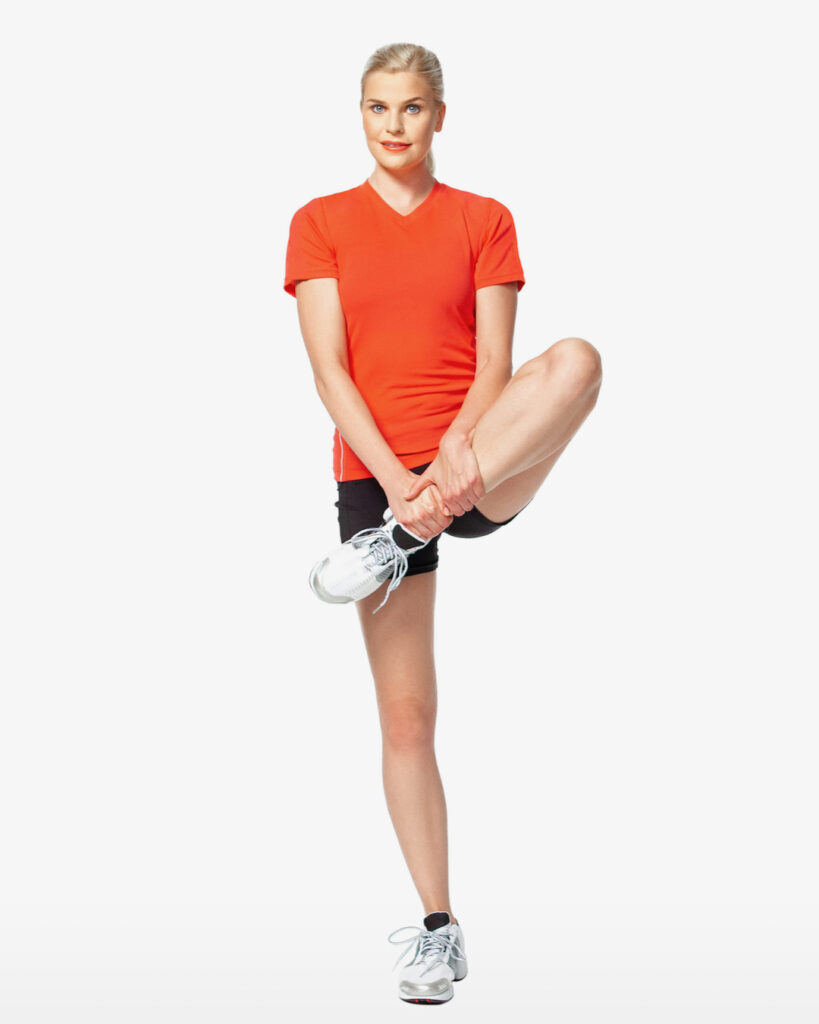
The Dynamic Piriformis Stretch warms up the musculature of the external hip rotators for explosive change of direction capabilities on the court.
Apart from preparing the musculature for explosive movements, the dynamic piriformis stretch reduces the risk for injury and improves flexibility of the external hip rotators.
Every time you are taking a step sideways, such as side stepping along the baseline, you engage the external hip rotators.
Since you are predominantly moving sideways and have to change direction repeatedly while playing tennis you should incorporate the dynamic piriformis stretch into your dynamic stretching routine.
Performing the dynamic piriformis stretch regularly can support proper pelvic realignment, which can be helpful in alleviating knee pain.
To achieve the benefits associated with the dynamic piriformis stretch perform the stretch regularly for 6-8 repetitions per leg.
Dynamic Piriformis Stretch Description Summary
- Stand on the left leg
- Move the right leg and bend the knee so that the toes point inside and the knee outside
- Grab the right chin with both hands
- Pull lower right leg up towards your hips
- Hold stretch for 1 second
- Release right leg, take a step, and repeat with left leg
Targeted Musculature
It targets the piriformis.
16. Quick Carioca Dynamic Stretch
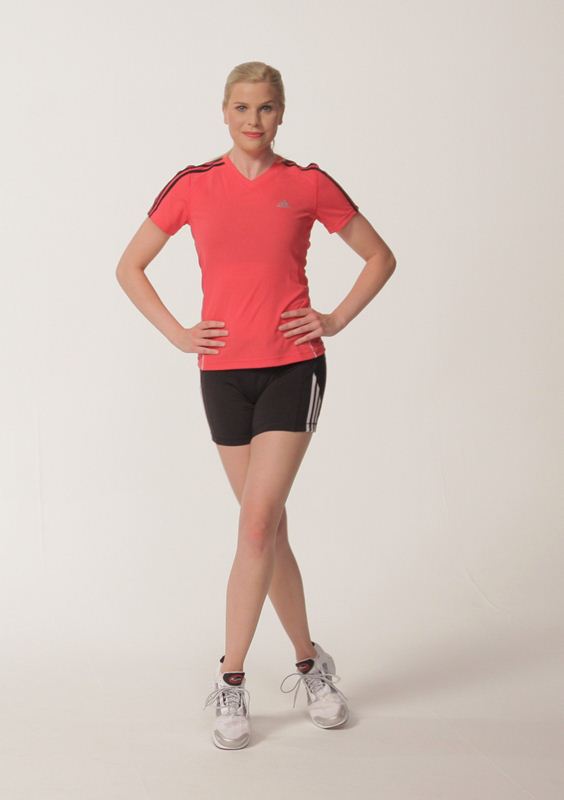
The Quick Carioca Dynamic Stretch warms up the musculature of the hip abductors and adductors used during lateral movement along the baseline.
Moreover, the quick carioca dynamic stretch prepares you for explosive lateral movement, reduces the risk of injury for the hip abductors and adductors and can improve flexibility by increasing muscle tissue temperature.
When you are performing the carioca steps you want to ensure that the hip remain in neutral position.
There shouldn’t be any hip rotation because we want to maintain as stable as possible during the movement.
Reason being is that when you move along the baseline you want to face your opponent while moving fast with your feet and staying loose with the upper body so that you can swing through the shot with ease.
In addition to that we also want to isolate the hip abductors and adductors.
Quick Carioca Dynamic Stretch Summary
- Perform anterior and posterior cross-overs in alternating fashion
- Hips maintain neutral during movement
Targeted Musculature
It targets the:
- hip abductors
- adductors
17. Single Leg Romanian Deadlift Dynamic Stretch
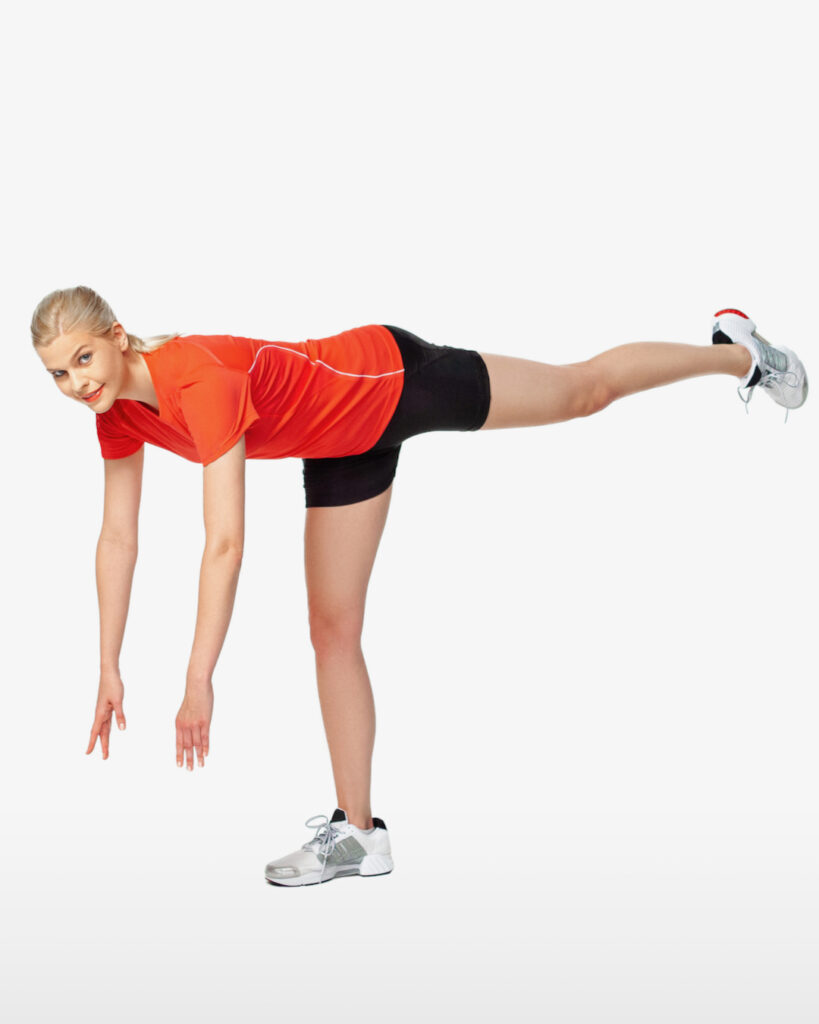
The Single Leg Romanian Deadlift Dynamic Stretch warms up the hamstrings for explosive knee flexion and hip extension used during the jump-phase of the serve.
Secondary to that the Single Leg Romanian Deadlift stretch reduces your risk for injury, improves flexibility of the posterior thigh musculature and enhances leg stabilizers action by increasing muscle tissue temperature.
Check out the knee flexion and hip extension during Roger Federer’s service:
Progression of the Single Leg Romanian Deadlift
If you are completely new to the single leg Romanian deadlift stretch then you can raise your arms sideways to facilitate your ability to maintain balanced throughout the movement.
More advanced athletes can extend their arms over the head while performing hip flexion.
Single Leg Romanian Deadlift Stretch Summary
- Stand on the left leg.
- Lower the upper-body as far towards the ground as possible while the right leg goes up as far as possible behind you.
- Maintain stability and hold stretch for a second.
- Return with upper-body and right leg to normal position.
- Stand on the right leg and repeat with left foot.
Targeted Musculature
It targets the hamstrings.
18. Single Leg Romanian Deadlift Quadriceps Stretch
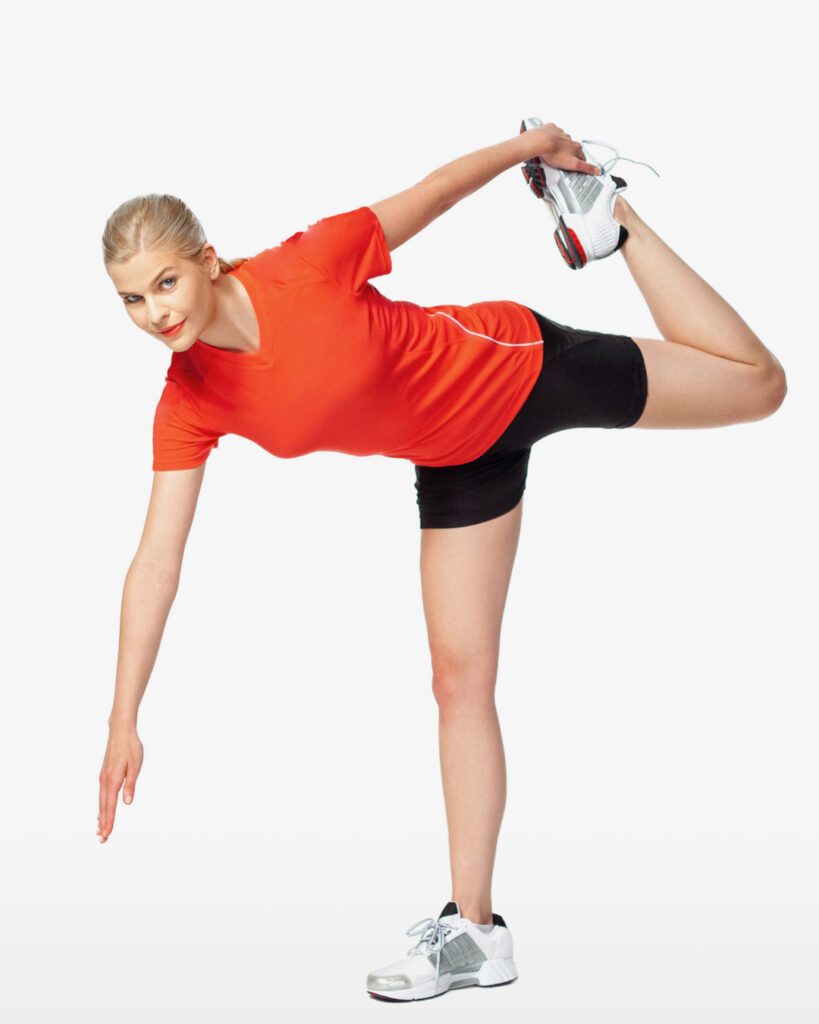
The Single Leg Romanian Deadlift with Quadriceps Stretch warms up the musculature of the anterior and posterior thigh used during sprinting and explosive jumping.
Aside from preparing you for explosive movements on the court, the single leg Romanian deadlift and quadriceps stretch reduces the risk of pulling a muscle, improves flexibility of the hamstrings and quadriceps and enhances your dynamic stability during groundstrokes.
Single Leg Romanian Deadlift Progressions
The single leg Romanian deadlift with quadriceps stretch is used by professional athletes. If you are new to exercise or play tennis recreationally then check out the Single Leg Romanian Deadlift Stretch.
Single Leg Romanian Deadlift Quadriceps Stretch Summary
- Stand on the left leg.
- Right hand grabs the toes of the right foot.
- Pull the right foot towards the buttocks while lowering the upper-body as far towards the ground as possible.
- Maintain stability and hold stretch for a second.
- Return upper-body to normal position and release the right hand.
- Stand on the right leg and repeat.
Targeted Musculature
It targets the:
- hamstrings
- quadriceps
19. Dynamic Squat Stretch

The Dynamic Squat Stretch warms up the musculature of the buttocks as well as anterior and posterior thigh used during running and jumping.
But that’s not all! The dynamic squat stretch also reduces the risk for injury, improves flexibility of the glutes and gets the hamstrings and quadriceps ready for explosive movements by elevating muscle tissue temperature.
Many tennis players use a semi squat position during the return stance so that they can push off the ground and move towards the ball to hit the return.
Dynamic Squat Stretch Progressions
If you are new to exercise then keep the arms in front of you while you perform the dynamic squat stretch. That makes it easier to maintain stability.
Advanced recreational players can lift their arms over the head when squatting and professional or college-level athletes can perform a single leg squat.
Dynamic Squat Stretch Description Summary
- Feet are shoulder width apart
- Flex hips and knees until knees are at 90˚
- Keep weight on the heels
- Back remains straight
- Extend knees and hips and return to standing position
Targeted Musculature
It targets the glutes, quadriceps and hip adductors.
20. Dynamic Squat with Overhead Reach Stretch
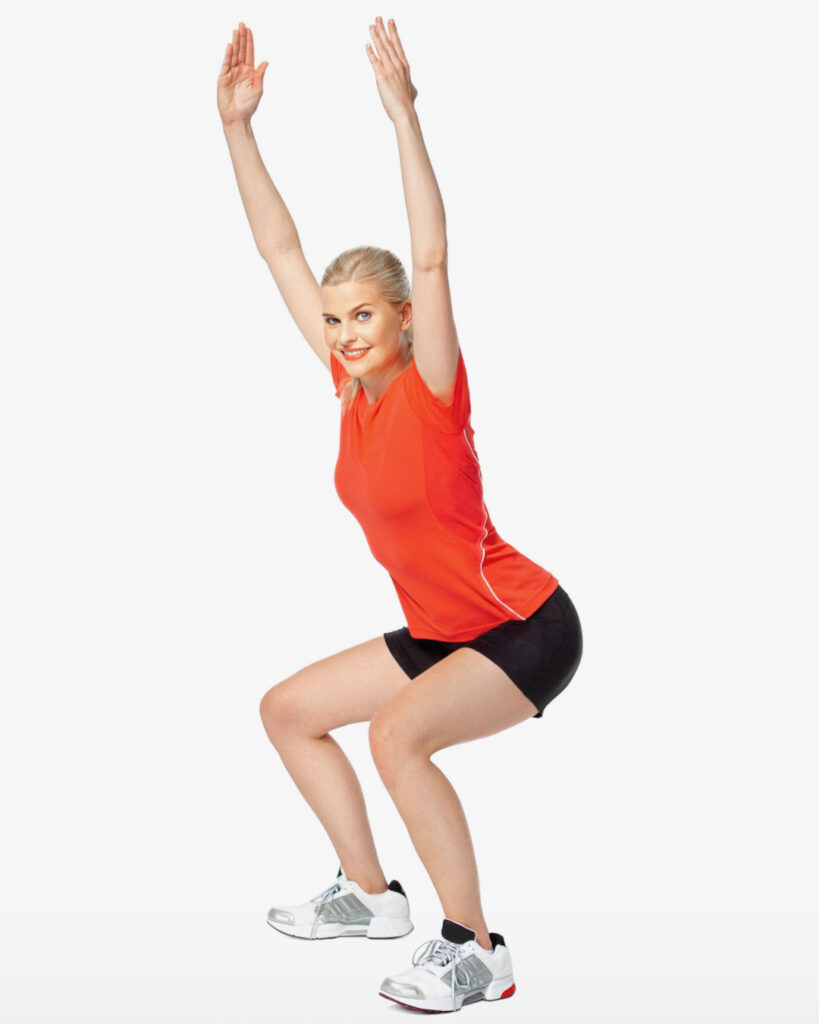
The Dynamic Squat with Overhead Reach Stretch warms up the muscles acting on the knee, hip and shoulders used during serving and groundstrokes.
The dynamic squat with overhead reach stretch prepares various muscle groups for burst action, reduces the risk for injury, improves flexibility of the glutes and lats and enhances stability properties.
If you have difficulties maintaining stability throughout the movement then try the dynamic squat stretch first.
Professional or college-level athletes can use the single leg version, which elevates the stability requirements, especially of the leg and trunk stabilizers.
Dynamic Squat with Overhead Reach Description
- Stand in athletic stance (feet are shoulder-width apart; knees are slightly bent), keep hands close to the body in front of you
- Flex hips until knees are at 90˚ and raise arms over your head; keep weight on the heels of the feet and arms wide over your head
- Extend hips until you are standing and lower arms to starting position
Targeted Musculature
It targets the:
- hip extensors
- hip adductors
- knee extensors
- deltoids
- latissimus dorsi
21. Straight Leg Kicks Dynamic Hamstring Stretch
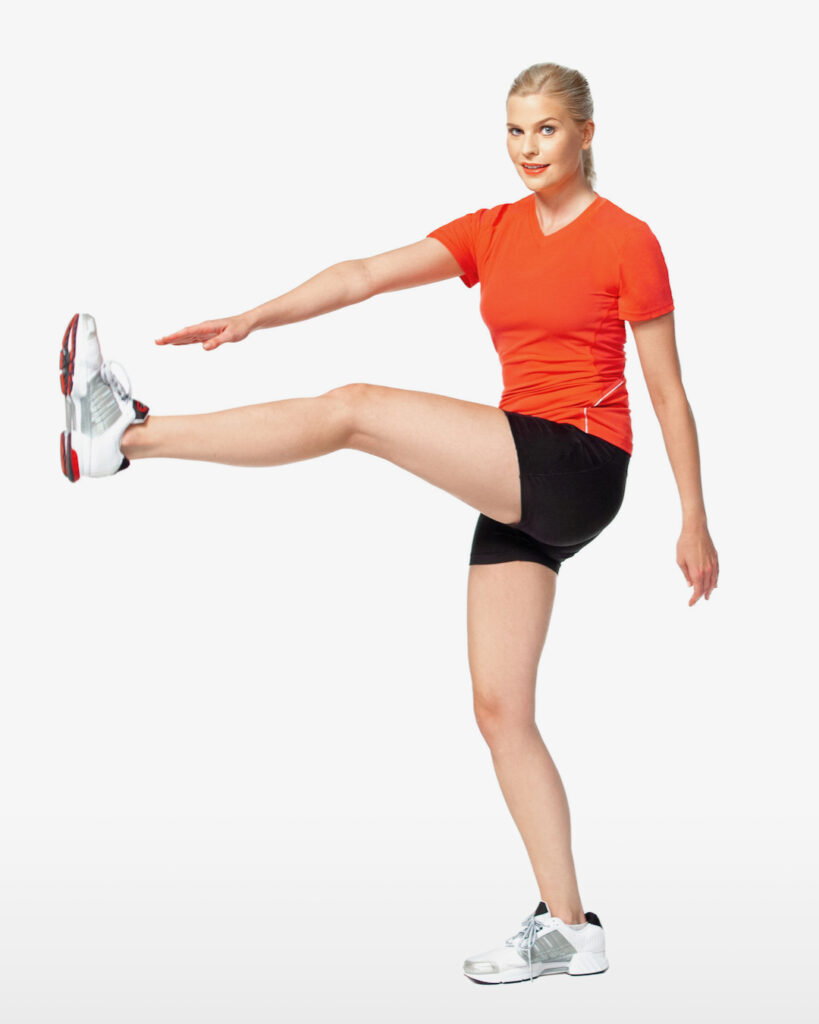
The Straight Leg Kicks Dynamic Hamstring Stretch warms up the musculature of the posterior thigh used during running and serving.
The straight leg kicks dynamic hamstring stretch prepares the hamstrings for explosive action, such as jumping during the serve, reduces the risk for injury and improves flexibility of the hamstrings by increasing muscle tissue temperature.
Ensure that you perform the straight leg kicks in a controlled fashion, especially if you haven’t performed any other warm up exercise before, because it is easy to pull the hamstrings when they are “cold”.
If you have hamstring flexibility issues then you might not be able to kick up the leg to hip level without flexing the knee. If that’s the case then raise the leg as far as possible without bending the knee.
Straight Leg Kicks Description Summary
- Keep leg straight and raise it as far in front of you as possible.
- The opposite hand touches the toes of the raised leg.
- Release the leg back to the ground and repeat.
Targeted Musculature
It targets the hamstrings.


